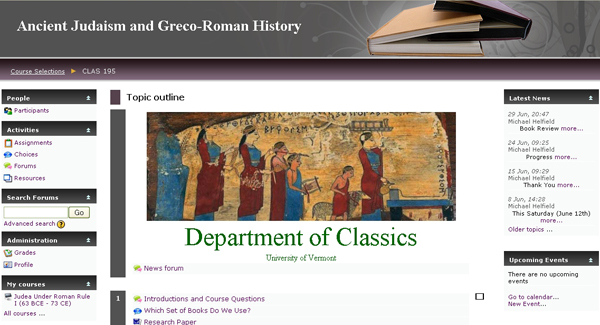IT in Education – Another Rhetorical Strategy
Like many teachers at the beginning of their careers, I teach in more than one school. In terms of information technology, this has proven to be a distinct advantage as I am experiencing IT from more than one vantage point.
My most memorable experience with IT to date has been at Champlain College, a career and technical college with a required interdisciplinary liberal arts component called CORE in Burlington Vermont (the school has a small Montreal campus located downtown). There I was introduced to the concept of Global Modules written by Dr Gary Scudder. While I was teaching one of the last history courses for students in programs being given before the interdisciplinary approach was put into effect, Dr Scudder asked if I would be willing to participate in a Global Module with a professor Mark Olson at Gulf University in Kuwait along with my colleague Signe Daly at Champlain.
Using the Global Modules, each teacher retains their own courses and their own curriculum. Dr Olson’s students were studying sociology while my course was a history course. We selected an interdisciplinary topic called Carbon Footprint and broached it from different directions. All Global Modules last four weeks and are designed to be mini-segments embedded within a course.
My students here were working together with the students in Kuwait basically in online forums. Each week had a distinct theme, and each student had to post at least twice a week and respond to other posts at least once a week.
- In Week One there were three subfolders: Introductions, Perceptions and Questions. The instructors wanted the course to be student-based as this would facilitate interactions by making students more independent. Once introductions were finished, the groups moved on to discussing their perceptions of each other. The last folder ‘Questions’ encouraged direct questions about the course and about each other.
- In Week 2 students started discussing the topic of ecology. Four articles that both sides had to read in common were taken from sources such as The Atlantic Monthly. The module contains discussion questions, and everyone must either answer or comment at least twice in a well thought out and reflective manner.
- In Week 3 there is a specific activity related to the geographic region that each student is living in. The results were compared, and there was a hands-on applied exercise using the internet as the main tool.
- In Week 4 you say your goodbyes, and ask another series of questions. What have we learned? Was the problem too big? What have we learned about each other?
Part of the idea behind the modules is that students see that other people are wrestling with the same issues that they are.
This dynamic teaching experience has transferred into my ESL classroom at Dawson College in that I have become wide open to technology, perhaps even considering integrating something similar to Global Modules into future classes. ESL classes at Dawson are given using a standard text. In my class, it is ‘Top Notch’. If I am assigned to a room with a computer and a data projector, I can use a program like Word to write words in a 30 point font that students are having difficulty with in the textbook. I can use the projector to highlight alternative expressions and control the graphic content of what I am presenting. In a given class, if I find that I have done a lot on the screen, I can save the work in a file and send it to my students. I have also used the internet for a section of the course involving ordering food at a restaurant. I projected the YouTube Sesame Street scene where Grover is a waiter at a restaurant and the order of the soup and the sandwich in the meal is under discussion.
Classic Sesame Street – what should Grover bring first?
Technology has allowed me to bring things into my lessons almost on a whim. If I have the technology ready and read the mood of the class, I can do things that are not on the course plan that will make the material more accessible. Most of my students speak Spanish, and I try to speak to them in their mother tongue at times not only to let them know that everyone is a beginner in one language or another but that comparative structures exist between the languages that they know and the language that they are learning. The text ‘Top Notch’ comes with a CD. I encourage students to use the CD even though I can’t be certain that everyone will have access to a player because it again makes the course more student centered. Given that the course is a conversation course, the audio content is an undeniable asset to their learning.

Moodle site for the Universty of Vermont.
Another resource at Dawson is Moodle. I started a Moodle site because of the influence of Rafael Scapin, Dawson’s IT Representative. I wound up teaching a course at the University of Vermont for two independent students and was able to set up my own Moodle website for students to upload assignments. Unfortunately, the two independent students didn’t finish the course, however, the experience of working in this collaborative, activity-based learning environment was invaluable, and I look forward to applying it in my future classes.
IT helps you respond to your students more effectively. I like the idea that we can also be more spontaneous using technology. For me technology is another rhetorical strategy. Like the joke you tell at the beginning of a class to break the ice, technology makes my students less scared of their subject and more open to learning.

